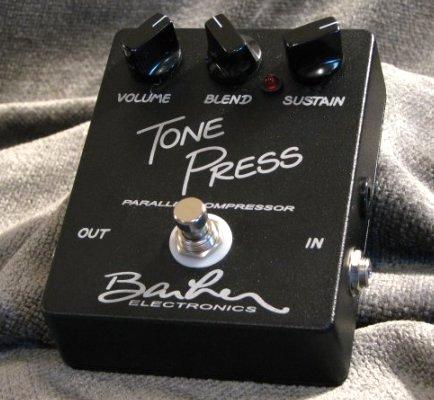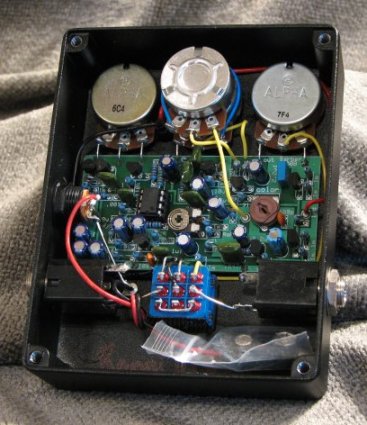The Barber Tone Press Guitar Compressor

The sound of compressed guitar is nearly unbiquitous in popular music. In recorded literature, guitars are compressed so often that it’s rare to hear one that isn’t compressed. For years, amateur guitarists pushed their amps to the wall trying to get the compressed sounds artists recorded by mildly pushing the amp and compressing the output of the microphone. Then came stomp-box guitar compressors such as the MXR Dynacomp. Beginning in the mid-'70s, some players began to build their signature sounds around stomp-box compressors. For example, towards the end of the ‘70s, the clean or moderately clean but compressed sound was made famous by the likes of Larry Carlton, based around his Gibson ES-335, and David Gilmour, based around his Fender Strat. However, when you start fiddling with basic two-knob guitar compressors, you soon notice that their sustain comes at the cost of squashing the living daylights out of the attack phase of the guitar’s signal, killing off the bloom of overtones and causing a characteristic pop. You can hear that on early recorded examples and when you play through many two-knob compressors. One easy to spot example of the pop is found on David Gilmour’s “Shine On You Crazy Diamond” clean intro solo sound.
Over the years since the seventies, manufacturers have tried various schemes to counteract this phenomenon, usually centering around placing a variable delay on the onset of the compressor to allow the attack to slip through before the effect takes hold. It works, but can be hard to manage as you vary your attack and so can often still sound kind of funky. Luckily, there has been a recent resurgence of analog effects, many of them hand-built by small manufacturers working to address the short-comings of classic designs. In 2002, small-shop effects builder David Barber came up a design to address the "problem of the pop." Barber's process, called "parallel compression," is based on a studio practice that involves routing a signal to two console channels and compressing only one. When properly blended with the compressed signal, the uncompressed signal provides the bloom of overtones and attack and drowns out the compressor's pop. Then the uncompressed signal naturally fades under the compressed signal as the stronger compressed signal continues to sustain. Engineers have used this to fatten up drum sounds for years. In the Barber Tone Press, a “Blend” control, really a post-effect mixer, allows you to blend between the uncompressed and compressed signals. Sweet! The “magic” is in the ability to maintain phase coherency throughout the system so there is no phase cancellation during summing.
 Barber suggests placing tape over the battery
Barber suggests placing tape over the battery
snap if you use the pedal without a battery.
I used a tiny ziplock bag.
The Barber Tone Press is a hand-built pedal housed in a rugged, crinkle-finished Pbox with a sturdy footswitch, pots and jacks. The pedal’s components live on one cleanly designed and executed double-sided PC board surrounded by neatly-dressed wiring. The design features a true bypass circuit driven by a TPDT switch, so your signal is completely unaffected by the unit when you bypass it. You can choose between battery power and a 9 volt wall supply of your choice via a standard Boss-type negative-tip barrel jack. A red front-panel LED is provided to tell you when the unit is engaged (it was green during the first year). There are four controls: "Level," "Blend," "Sustain," and "Color," with the last being a trim pot inside the box. As described, “Blend” mixes between compressed and dry sound. At 12 o’clock, it is an even mix ‘twixt the two. “Level” sets the overall operating level of the unit. When the Blend control is set at 7 o’clock (dry, no compression) and Level is set above unity (2 o’clock) the unit can function as a clean class-A boost pedal offering about 8db of boost. “Sustain” functions like the "Sensitivity" control on many stompbox compressors, combining a compression ratio control with a gain make-up so that as you compress more and more, the overall level remains realtively constant.
 Pretty simple, isn't it?
Pretty simple, isn't it?
So, how does it sound? The Tone Press does exactly what Barber says it does and does so unremarkably, with few noticeable artifacts - and that unremarkable quality is at the heart of this pedal. At 12 o’clock on the Blend control, you get marvelous sustain with natural attack and no odd transition between the two. Unless you intentionally crank everything up to full, the effect is so subtle and there is so little background noise that at first you aren’t exactly sure the pedal is even engaged. And then you hold a note. Hello! Gobs of smooth sustain. Now THIS is how compression is supposed to be. Very subtle - much like an expensive studio unit. Very nice, indeed. If you want to compress the poop out of things and maybe want that little “pop” caused by the artifacts, just twist the Blend towards the right and you are back in hard compression land.
Now, what about that “Color” trim control inside the box? Well, that’s interesting. The unit is shipped with the color control opened up wide, in which position it affects the EQ of the signal very little. According to the manual, backing it down imparts a round, “vintage quality” to the compressed chain. According to David, the "Color" control is a high frequency roll-off applied to the compressed side of the signal only. From what I can tell, it is offered to mitigate the pop a bit if you run with the Blend hard over towards compression. I prefer the sound wth the trim opened all the way and the Blend used to mix the uncompressed sound in to preserve the attack.
So, we have here a remarkable piece of design and construction that accomplishes everything it set out to do but almost underwhelms you with its elegant simplicity and transparency. Surely, that is the definition of "virtue" in pedal design. And once again, a creative designer has upheld Arthur C. Clarke’s notion that “Any sufficiently advanced technology is indistinguishable from magic.”

BARBER ELECTRONICS

= =
=






